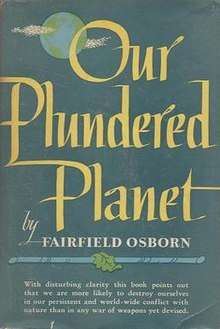Our Plundered Planet
Our Plundered Planet is a book published in 1948 that was written by Fairfield Osborn about environmental destruction by humankind. With a focus on soil, the book is a critique of humankind's poor stewardship of Earth. It typifies the earliest apocalyptic environmental literature, in which human beings are seen as destroyers of the natural world.[1]
 First US edition, Little, Brown and Company | |
| Author | Fairfield Osborn |
|---|---|
| Country | United States |
| Language | English |
| Subject | Environment |
| Genre | Non-fiction |
| Publisher | Little, Brown and Company |
Publication date | 1948 |
Our Plundered Planet, along with William Vogt’s Road to Survival, also published in 1948, launched a Malthusian revival in the post War era, and would inspire Paul R. Ehrlich, author of The Population Bomb among many others.[2]
Influences
In writing this book, Osborn was influenced by Guy I. Burch and Elmer Pendell’s overpopulation tract Population Roads to Peace or War (1945) and Paul Sears’ analysis of dust bowls in Deserts on the March (1935). He had also been influenced by various "New Deal" initiatives in the public planning of land use and restoration, such as the creation of the Tennessee Valley Authority, the Civilian Conservation Corps and various policies to address the “dust bowls” of the time. Osborn, as well as his famous father, Henry Fairfield Osborn, was also heavily influenced by the eugenics movement prior to the war.[2]
Editions
- US edition: Little, Brown and Company, 1948.
- UK edition: Faber and Faber, London, 1948.
- French translation published in 1949 (La planète au pillage).
- German edition: 1950, Pan-Verlag, Zürich, Switzerland, translated by Fritz Levi, foreword: Paul Reiwald (Univ. Genf), title: Unsere ausgeplünderte Erde, 161 pages.
References
- Netzley, Patricia (1999). Environmental Literature. California: ABC-CLIO. ISBN 1-57607-000-X.
- Pierre Desrochers; Christine Hoffbauer (2009). "The Post War Intellectual Roots of the Population Bomb" (PDF). The Electronic Journal of Sustainable Development. 1 (3): 73–97. Archived from the original (PDF) on 2012-03-02. Retrieved 2010-02-01.